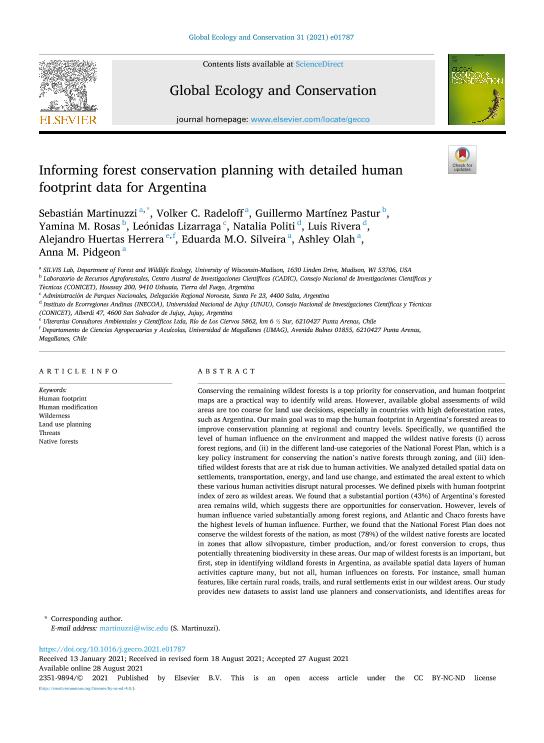Mostrar el registro sencillo del ítem
dc.contributor.author
Martinuzzi, Sebastián

dc.contributor.author
Radeloff, Volker

dc.contributor.author
Martínez Pastur, Guillermo José

dc.contributor.author
Rosas, Yamina Micaela

dc.contributor.author
Lizarraga, Leónidas
dc.contributor.author
Politi, Natalia

dc.contributor.author
Rivera, Luis Osvaldo

dc.contributor.author
Huertas Herrera, Alejandro

dc.contributor.author
Silveira, Eduarda
dc.contributor.author
Olah, Ashley
dc.contributor.author
Pidgeon, Anna Michle

dc.date.available
2021-10-29T11:16:17Z
dc.date.issued
2021-11
dc.identifier.citation
Martinuzzi, Sebastián; Radeloff, Volker; Martínez Pastur, Guillermo José; Rosas, Yamina Micaela; Lizarraga, Leónidas; et al.; Informing forest conservation planning with detailed human footprint data for Argentina; Elsevier; Global Ecology and Conservation; 31; 11-2021; 1-14
dc.identifier.issn
2351-9894
dc.identifier.uri
http://hdl.handle.net/11336/145437
dc.description.abstract
Conserving the remaining wildest forests is a top priority for conservation, and human footprint maps are a practical way to identify wild areas. However, available global assessments of wild areas are too coarse for land use decisions, especially in countries with high deforestation rates, such as Argentina. Our main goal was to map the human footprint in Argentina's forested areas to improve conservation planning at regional and country levels. Specifically, we quantified the level of human influence on the environment and mapped the wildest native forests (i) across forest regions, and (ii) in the different land-use categories of the National Forest Plan, which is a key policy instrument for conserving the nation's native forests through zoning, and (iii) identified wildest forests that are at risk due to human activities. We analyzed detailed spatial data on settlements, transportation, energy, and land use change, and estimated the areal extent to which these various human activities disrupt natural processes. We defined pixels with human footprint index of zero as wildest areas. We found that a substantial portion (43%) of Argentina's forested area remains wild, which suggests there are opportunities for conservation. However, levels of human influence varied substantially among forest regions, and Atlantic and Chaco forests have the highest levels of human influence. Further, we found that the National Forest Plan does not conserve the wildest forests of the nation, as most (78%) of the wildest native forests are located in zones that allow silvopasture, timber production, and/or forest conversion to crops, thus potentially threatening biodiversity in these areas. Our map of wildest forests is an important, but first, step in identifying wildland forests in Argentina, as available spatial data layers of human activities capture many, but not all, human influences on forests. For instance, small human features, like certain rural roads, trails, and rural settlements exist in our wildest areas. Our study provides new datasets to assist land use planners and conservationists, and identifies areas for conservation attention in Argentina. More broadly, our analyses highlight the value of detailed human footprint data to support conservation decisions in forest landscapes.
dc.format
application/pdf
dc.language.iso
eng
dc.publisher
Elsevier

dc.rights
info:eu-repo/semantics/openAccess
dc.rights.uri
https://creativecommons.org/licenses/by-nc-nd/2.5/ar/
dc.subject
HUMAN FOOTPRINT
dc.subject
HUMAN MODIFICATION
dc.subject
LAND USE PLANNING
dc.subject
NATIVE FORESTS
dc.subject
THREATS
dc.subject
WILDERNESS
dc.subject.classification
Silvicultura

dc.subject.classification
Agricultura, Silvicultura y Pesca

dc.subject.classification
CIENCIAS AGRÍCOLAS

dc.title
Informing forest conservation planning with detailed human footprint data for Argentina
dc.type
info:eu-repo/semantics/article
dc.type
info:ar-repo/semantics/artículo
dc.type
info:eu-repo/semantics/publishedVersion
dc.date.updated
2021-10-15T14:57:51Z
dc.journal.volume
31
dc.journal.pagination
1-14
dc.journal.pais
Países Bajos

dc.journal.ciudad
Amsterdam
dc.description.fil
Fil: Martinuzzi, Sebastián. University of Wisconsin; Estados Unidos
dc.description.fil
Fil: Radeloff, Volker. University of Wisconsin; Estados Unidos
dc.description.fil
Fil: Martínez Pastur, Guillermo José. Consejo Nacional de Investigaciones Científicas y Técnicas. Centro Austral de Investigaciones Científicas; Argentina
dc.description.fil
Fil: Rosas, Yamina Micaela. Consejo Nacional de Investigaciones Científicas y Técnicas. Centro Austral de Investigaciones Científicas; Argentina
dc.description.fil
Fil: Lizarraga, Leónidas. Administración de Parques Nacionales; Argentina
dc.description.fil
Fil: Politi, Natalia. Universidad Nacional de Jujuy. Instituto de Ecorregiones Andinas. Consejo Nacional de Investigaciones Científicas y Técnicas. Centro Científico Tecnológico Conicet - Salta. Instituto de Ecorregiones Andinas; Argentina
dc.description.fil
Fil: Rivera, Luis Osvaldo. Universidad Nacional de Jujuy. Instituto de Ecorregiones Andinas. Consejo Nacional de Investigaciones Científicas y Técnicas. Centro Científico Tecnológico Conicet - Salta. Instituto de Ecorregiones Andinas; Argentina
dc.description.fil
Fil: Huertas Herrera, Alejandro. Consejo Nacional de Investigaciones Científicas y Técnicas. Centro Austral de Investigaciones Científicas; Argentina
dc.description.fil
Fil: Silveira, Eduarda. University of Wisconsin; Estados Unidos
dc.description.fil
Fil: Olah, Ashley. University of Wisconsin; Estados Unidos
dc.description.fil
Fil: Pidgeon, Anna Michle. University of Wisconsin; Estados Unidos
dc.journal.title
Global Ecology and Conservation
dc.relation.alternativeid
info:eu-repo/semantics/altIdentifier/url/https://www.sciencedirect.com/science/article/pii/S2351989421003371?via%3Dihub
dc.relation.alternativeid
info:eu-repo/semantics/altIdentifier/doi/https://doi.org/10.1016/j.gecco.2021.e01787
Archivos asociados
